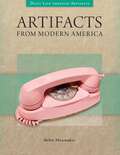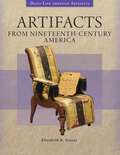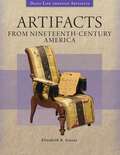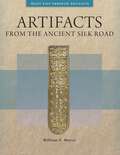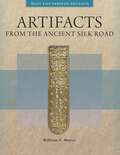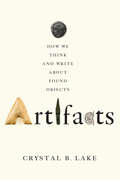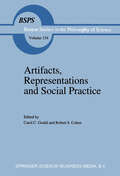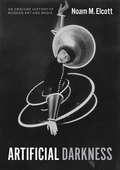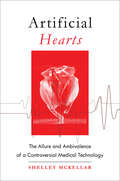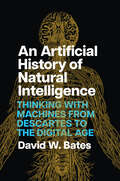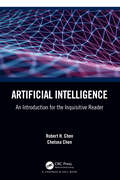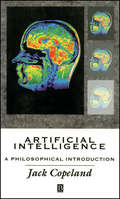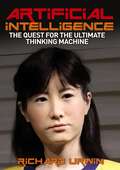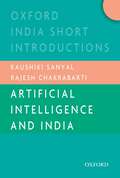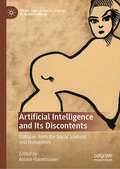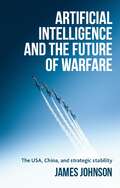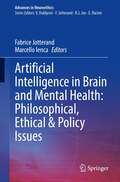- Table View
- List View
Artifacts from Modern America (Daily Life through Artifacts)
by Helen SheumakerThis intriguing book examines how material objects of the 20th century—ranging from articles of clothing to tools and weapons, communication devices, and toys and games—reflect dominant ideas and testify to the ways social change happens.Objects of everyday life tell stories about the ways everyday Americans lived. Some are private or personal things—such as Maidenform brassiere or a pair of patched blue jeans. Some are public by definition, such as the bus Rosa Parks boarded and refused to move back for a white passenger. Some material things or inventions reflect the ways public policy affected the lives of Americans, such as the Enovid birth control pill. An invention like the electric wheelchair benefited both the private and public spheres: it eased the lives of physically disabled individuals, and it played a role in assisting those with disabilities to campaign successfully for broader civil rights.Artifacts from Modern America demonstrates how dozens of the material objects, items, technologies, or inventions of the 20th century serve as a window into a period of history. After an introductory discussion of how to approach material culture—the world of things—to better understand the American past, essays describe objects from the previous century that made a wide-ranging or long-lasting impact. The chapters reflect the ways that communication devices, objects of religious life, household appliances, vehicles, and tools and weapons changed the lives of everyday Americans. Readers will learn how to use material culture in their own research through the book's detailed examples of how interpreting the historical, cultural, and social context of objects can provide a better understanding of the 20th-century experience.
Artifacts from Modern America (Daily Life through Artifacts)
by Helen SheumakerThis intriguing book examines how material objects of the 20th century—ranging from articles of clothing to tools and weapons, communication devices, and toys and games—reflect dominant ideas and testify to the ways social change happens.Objects of everyday life tell stories about the ways everyday Americans lived. Some are private or personal things—such as Maidenform brassiere or a pair of patched blue jeans. Some are public by definition, such as the bus Rosa Parks boarded and refused to move back for a white passenger. Some material things or inventions reflect the ways public policy affected the lives of Americans, such as the Enovid birth control pill. An invention like the electric wheelchair benefited both the private and public spheres: it eased the lives of physically disabled individuals, and it played a role in assisting those with disabilities to campaign successfully for broader civil rights.Artifacts from Modern America demonstrates how dozens of the material objects, items, technologies, or inventions of the 20th century serve as a window into a period of history. After an introductory discussion of how to approach material culture—the world of things—to better understand the American past, essays describe objects from the previous century that made a wide-ranging or long-lasting impact. The chapters reflect the ways that communication devices, objects of religious life, household appliances, vehicles, and tools and weapons changed the lives of everyday Americans. Readers will learn how to use material culture in their own research through the book's detailed examples of how interpreting the historical, cultural, and social context of objects can provide a better understanding of the 20th-century experience.
Artifacts from Nineteenth-Century America (Daily Life through Artifacts)
by Elizabeth B. GreeneThis book presents both nationally significant objects and ordinary items from everyday life to provide insight into 19th century American society, showing readers how the production, design, function, and use of these objects can inform our understanding of the period.Artifacts from 19th Century America examines a broad array of objects representing various aspects of 19th century American society. The objects have been chosen to illuminate daily life in a number of categories including cooking, entertainment, grooming, clothing and accessories, health, household items, religious life, work, and education.The book's 53 entries include a brief introduction to the background of the object, when and why it was made, and who used it, followed by a detailed description of the object itself. Finally, each entry provides a deep dive into the object's significance and how the object reveals clues about the social, political, economic, and intellectual life of the society in which it was produced and utilized. Students and general readers alike will not only learn about the time period but also learn to use the skills of material culture theory and method, including how to draw meaningful conclusions from each object about their historical context and significance.
Artifacts from Nineteenth-Century America (Daily Life through Artifacts)
by Elizabeth B. GreeneThis book presents both nationally significant objects and ordinary items from everyday life to provide insight into 19th century American society, showing readers how the production, design, function, and use of these objects can inform our understanding of the period.Artifacts from 19th Century America examines a broad array of objects representing various aspects of 19th century American society. The objects have been chosen to illuminate daily life in a number of categories including cooking, entertainment, grooming, clothing and accessories, health, household items, religious life, work, and education.The book's 53 entries include a brief introduction to the background of the object, when and why it was made, and who used it, followed by a detailed description of the object itself. Finally, each entry provides a deep dive into the object's significance and how the object reveals clues about the social, political, economic, and intellectual life of the society in which it was produced and utilized. Students and general readers alike will not only learn about the time period but also learn to use the skills of material culture theory and method, including how to draw meaningful conclusions from each object about their historical context and significance.
Artifacts from the Ancient Silk Road (Daily Life through Artifacts)
by William E. MierseArtifacts from the Ancient Silk Road explores the interconnectivity of the Eurasian continent from 4000 BCE to 1000 CE. It focuses on the role played by Central Asia through which passed the major trade routes, the Silk Roads.Artifacts from the Ancient Silk Road covers life along the Silk Road over 5000 years as it can be understood by considering objects. In this first object-based study to consider all of the peoples involved on the Silk Roads, objects provide the vehicles for explorations of different aspects of life for the various peoples of the Silk Roads, including the sedentary peoples who established urban life on the Silk Roads, the steppe nomads who regularly interacted with the settled peoples, and the peoples at either end of the Silk Roads who drove certain kinds of economic exchanges.The book looks at Central Asia as an international zone during ancient times when multiple religious, political, and technological ideas found acceptance in the region and allows for a better understanding of how some ideas and forms developed in Central Asia while others passed through or were modified.
Artifacts from the Ancient Silk Road (Daily Life through Artifacts)
by William E. MierseArtifacts from the Ancient Silk Road explores the interconnectivity of the Eurasian continent from 4000 BCE to 1000 CE. It focuses on the role played by Central Asia through which passed the major trade routes, the Silk Roads.Artifacts from the Ancient Silk Road covers life along the Silk Road over 5000 years as it can be understood by considering objects. In this first object-based study to consider all of the peoples involved on the Silk Roads, objects provide the vehicles for explorations of different aspects of life for the various peoples of the Silk Roads, including the sedentary peoples who established urban life on the Silk Roads, the steppe nomads who regularly interacted with the settled peoples, and the peoples at either end of the Silk Roads who drove certain kinds of economic exchanges.The book looks at Central Asia as an international zone during ancient times when multiple religious, political, and technological ideas found acceptance in the region and allows for a better understanding of how some ideas and forms developed in Central Asia while others passed through or were modified.
Artifacts (PDF): How We Think and Write about Found Objects
by Crystal LakeIn the eighteenth century, antiquaries—wary of the biases of philosophers, scientists, politicians, and historians—used old objects to establish what they claimed was a true account of history. But just what could these small, fragmentary, frequently unidentifiable things, whose origins were unknown and whose worth or meaning was not self-evident, tell people about the past?In Artifacts, Crystal B. Lake unearths the four kinds of old objects that were most frequently found and cataloged in Enlightenment-era England: coins, manuscripts, weapons, and grave goods. Following these prized objects as they made their way into popular culture, Lake develops new interpretations of works by Joseph Addison, John Dryden, Horace Walpole, Jonathan Swift, Tobias Smollett, Lord Byron, and Percy Bysshe Shelley, among others. Rereading these authors with the artifact in mind uncovers previously unrecognized allusions that unravel works we thought we knew well. In this new history of antiquarianism and, by extension, historiography, Lake reveals that artifacts rarely acted as agents of fact, as those who studied them would have claimed. Instead, she explains, artifacts are objects unlike any other. Fragmented and from another time or place, artifacts invite us to fill in their shapes and complete their histories with our imaginations. Composed of body as well as spirit and located in the present as well as the past, artifacts inspire speculative reconstructions that frequently contradict one another. Lake's history and theory of the artifact will be of particular importance to scholars of material culture and forms. This fascinating book provides curious readers with new ways of evaluating the relationships that exist between texts and objects.
Artifacts, Representations and Social Practice: Essays for Marx Wartofsky (Boston Studies in the Philosophy and History of Science #154)
by C. Gould Robert S. CohenThe essays collected here in honor of Marx Wartofsky's sixty-fifth birthday are a celebration of his rich contribution to philosophy over the past four decades and a testimony to the wide influence he has had on thinkers with quite various approaches of their own. His diverse philosophical interests and main themes have ranged from constructivism and realism in the philosophy of science to practices of representation and the creation of artifacts in aesthetics; and from the development of human cognition and the historicity of modes of knowing to the construction of norms in the context of concrete social critique. Or again, in the history of philosophy, his work spans historical approaches to Hegel, Feuerbach, and Marx, as well as contemporary implications of their work; and in applied philosophy, problems of education, medicine, and new technologies. Marx's philosophical theorizing moves from the highest levels of abstraction to the most concrete concern with the everyday and with contemporary social and political reality. And perhaps most notably, it is acutely sensitive to the importance of historical development and social practice. As a student of John Herman Randall, Jr. and Ernest Nagel at Columbia, Marx developed an exemplary background in both the history of philosophy and systematic philosophy and subsequently combined this with a wide acquaintance with analytic philosophy. He is at once aware of the requirements of system and of the need for rigorous and careful detailed argument.
Artificial Darkness: An Obscure History of Modern Art and Media
by Noam M. ElcottDarkness has a history and a uniquely modern form. Distinct from night, shadows, and artificial light, “artificial darkness” has been overlooked—until now. In fact, controlled darkness was essential to the rise of photography and cinema, science and spectacle, and a century of advanced art and film. Artificial Darkness is the first book to historicize and theorize this phenomenon and map its applications across a range of media and art forms. In exploring how artificial darkness shaped modern art, film, and media, Noam M. Elcott addresses seminal and obscure works alongside their sites of production—such as photography darkrooms, film studios, and laboratories—and their sites of reception, including theaters, cinemas, and exhibitions. He argues that artists, scientists, and entertainers like Étienne-Jules Marey, Richard Wagner, Georges Méliès, and Oskar Schlemmer revolutionized not only images but also everything surrounding them: the screen, the darkness, and the experience of bodies and space. At the heart of the book is “the black screen,” a technology of darkness that spawned today’s blue and green screens and has undergirded numerous advanced art and film practices to this day. Turning familiar art and film narratives on their heads, Artificial Darkness is a revolutionary treatment of an elusive, yet fundamental, aspect of art and media history.
Artificial Darkness: An Obscure History of Modern Art and Media
by Noam M. ElcottDarkness has a history and a uniquely modern form. Distinct from night, shadows, and artificial light, “artificial darkness” has been overlooked—until now. In fact, controlled darkness was essential to the rise of photography and cinema, science and spectacle, and a century of advanced art and film. Artificial Darkness is the first book to historicize and theorize this phenomenon and map its applications across a range of media and art forms. In exploring how artificial darkness shaped modern art, film, and media, Noam M. Elcott addresses seminal and obscure works alongside their sites of production—such as photography darkrooms, film studios, and laboratories—and their sites of reception, including theaters, cinemas, and exhibitions. He argues that artists, scientists, and entertainers like Étienne-Jules Marey, Richard Wagner, Georges Méliès, and Oskar Schlemmer revolutionized not only images but also everything surrounding them: the screen, the darkness, and the experience of bodies and space. At the heart of the book is “the black screen,” a technology of darkness that spawned today’s blue and green screens and has undergirded numerous advanced art and film practices to this day. Turning familiar art and film narratives on their heads, Artificial Darkness is a revolutionary treatment of an elusive, yet fundamental, aspect of art and media history.
Artificial Darkness: An Obscure History of Modern Art and Media
by Noam M. ElcottDarkness has a history and a uniquely modern form. Distinct from night, shadows, and artificial light, “artificial darkness” has been overlooked—until now. In fact, controlled darkness was essential to the rise of photography and cinema, science and spectacle, and a century of advanced art and film. Artificial Darkness is the first book to historicize and theorize this phenomenon and map its applications across a range of media and art forms. In exploring how artificial darkness shaped modern art, film, and media, Noam M. Elcott addresses seminal and obscure works alongside their sites of production—such as photography darkrooms, film studios, and laboratories—and their sites of reception, including theaters, cinemas, and exhibitions. He argues that artists, scientists, and entertainers like Étienne-Jules Marey, Richard Wagner, Georges Méliès, and Oskar Schlemmer revolutionized not only images but also everything surrounding them: the screen, the darkness, and the experience of bodies and space. At the heart of the book is “the black screen,” a technology of darkness that spawned today’s blue and green screens and has undergirded numerous advanced art and film practices to this day. Turning familiar art and film narratives on their heads, Artificial Darkness is a revolutionary treatment of an elusive, yet fundamental, aspect of art and media history.
Artificial Hearts: The Allure and Ambivalence of a Controversial Medical Technology
by Shelley McKellarArtificial hearts are seductive devices. Their promissory nature as a cure for heart failure aligned neatly with the twentieth-century American medical community;€™s view of the body as an entity of replacement parts. In Artificial Hearts, Shelley McKellar traces the controversial history of this imperfect technology beginning in the 1950s and leading up to the present day. McKellar profiles generations of researchers and devices as she traces the heart;€™s development and clinical use. She situates the events of Dr. Michael DeBakey and Dr. Denton Cooley;€™s professional fall-out after the first artificial heart implant case in 1969, as well as the 1982;€“83 Jarvik-7 heart implant case of Barney Clark, within a larger historical trajectory. She explores how some individuals;¢;‚¬;€?like former US Vice President Dick Cheney;¢;‚¬;€?affected the public profile of this technology by choosing to be implanted with artificial hearts. Finally, she explains the varied physical experiences, both negative and positive, of numerous artificial heart recipients. McKellar argues that desirability;¢;‚¬;€?rather than the feasibility or practicality of artificial hearts;¢;‚¬;€?drove the invention of the device. Technical challenges and unsettling clinical experiences produced an ambivalence toward its continued development by many researchers, clinicians, politicians, bioethicists, and the public. But the potential and promise of the artificial heart offset this ambivalence, influencing how success was characterized and by whom. Packed with larger-than-life characters;¢;‚¬;€?from dedicated and ardent scientists to feuding Texas surgeons and brave patients;¢;‚¬;€?this book is a fascinating case study that speaks to questions of expectations, limitations, and uncertainty in a high-technology medical world.
Artificial Hearts: The Allure and Ambivalence of a Controversial Medical Technology
by Shelley McKellarArtificial hearts are seductive devices. Their promissory nature as a cure for heart failure aligned neatly with the twentieth-century American medical community;€™s view of the body as an entity of replacement parts. In Artificial Hearts, Shelley McKellar traces the controversial history of this imperfect technology beginning in the 1950s and leading up to the present day. McKellar profiles generations of researchers and devices as she traces the heart;€™s development and clinical use. She situates the events of Dr. Michael DeBakey and Dr. Denton Cooley;€™s professional fall-out after the first artificial heart implant case in 1969, as well as the 1982;€“83 Jarvik-7 heart implant case of Barney Clark, within a larger historical trajectory. She explores how some individuals;¢;‚¬;€?like former US Vice President Dick Cheney;¢;‚¬;€?affected the public profile of this technology by choosing to be implanted with artificial hearts. Finally, she explains the varied physical experiences, both negative and positive, of numerous artificial heart recipients. McKellar argues that desirability;¢;‚¬;€?rather than the feasibility or practicality of artificial hearts;¢;‚¬;€?drove the invention of the device. Technical challenges and unsettling clinical experiences produced an ambivalence toward its continued development by many researchers, clinicians, politicians, bioethicists, and the public. But the potential and promise of the artificial heart offset this ambivalence, influencing how success was characterized and by whom. Packed with larger-than-life characters;¢;‚¬;€?from dedicated and ardent scientists to feuding Texas surgeons and brave patients;¢;‚¬;€?this book is a fascinating case study that speaks to questions of expectations, limitations, and uncertainty in a high-technology medical world.
An Artificial History of Natural Intelligence: Thinking with Machines from Descartes to the Digital Age
by David W. BatesA new history of human intelligence that argues that humans know themselves by knowing their machines. We imagine that we are both in control of and controlled by our bodies—autonomous and yet automatic. This entanglement, according to David W. Bates, emerged in the seventeenth century when humans first built and compared themselves with machines. Reading varied thinkers from Descartes to Kant to Turing, Bates reveals how time and time again technological developments offered new ways to imagine how the body’s automaticity worked alongside the mind’s autonomy. Tracing these evolving lines of thought, An Artificial History of Natural Intelligence offers a new theorization of the human as a being that is dependent on technology and produces itself as an artificial automaton without a natural, outside origin.
An Artificial History of Natural Intelligence: Thinking with Machines from Descartes to the Digital Age
by David W. BatesA new history of human intelligence that argues that humans know themselves by knowing their machines. We imagine that we are both in control of and controlled by our bodies—autonomous and yet automatic. This entanglement, according to David W. Bates, emerged in the seventeenth century when humans first built and compared themselves with machines. Reading varied thinkers from Descartes to Kant to Turing, Bates reveals how time and time again technological developments offered new ways to imagine how the body’s automaticity worked alongside the mind’s autonomy. Tracing these evolving lines of thought, An Artificial History of Natural Intelligence offers a new theorization of the human as a being that is dependent on technology and produces itself as an artificial automaton without a natural, outside origin.
Artificial Intelligence: An Introduction for the Inquisitive Reader
by Robert H. Chen Chelsea C. ChenArtificial Intelligence: An Introduction for the Inquisitive Reader guides readers through the history and development of AI, from its early mathematical beginnings through to the exciting possibilities of its potential future applications. To make this journey as accessible as possible, the authors build their narrative around accounts of some of the more popular and well-known demonstrations of artificial intelligence including Deep Blue, AlphaGo and even Texas Hold’em, followed by their historical background, so that AI can be seen as a natural development of mathematics and computer science. As the book moves forward, more technical descriptions are presented at a pace that should be suitable for all levels of readers, gradually building a broad and reasonably deep understanding and appreciation for the basic mathematics, physics, and computer science that is rapidly developing artificial intelligence as it is today. Features Only mathematical prerequisite is an elementary knowledge of calculus Accessible to anyone with an interest in AI and its mathematics and computer science Suitable as a supplementary reading for a course in AI or the History of Mathematics and Computer Science in regard to artificial intelligence.
Artificial Intelligence: An Introduction for the Inquisitive Reader
by Robert H. Chen Chelsea C. ChenArtificial Intelligence: An Introduction for the Inquisitive Reader guides readers through the history and development of AI, from its early mathematical beginnings through to the exciting possibilities of its potential future applications. To make this journey as accessible as possible, the authors build their narrative around accounts of some of the more popular and well-known demonstrations of artificial intelligence including Deep Blue, AlphaGo and even Texas Hold’em, followed by their historical background, so that AI can be seen as a natural development of mathematics and computer science. As the book moves forward, more technical descriptions are presented at a pace that should be suitable for all levels of readers, gradually building a broad and reasonably deep understanding and appreciation for the basic mathematics, physics, and computer science that is rapidly developing artificial intelligence as it is today. Features Only mathematical prerequisite is an elementary knowledge of calculus Accessible to anyone with an interest in AI and its mathematics and computer science Suitable as a supplementary reading for a course in AI or the History of Mathematics and Computer Science in regard to artificial intelligence.
Artificial Intelligence: A Philosophical Introduction
by Jack CopelandPresupposing no familiarity with the technical concepts of either philosophy or computing, this clear introduction reviews the progress made in AI since the inception of the field in 1956. Copeland goes on to analyze what those working in AI must achieve before they can claim to have built a thinking machine and appraises their prospects of succeeding. There are clear introductions to connectionism and to the language of thought hypothesis which weave together material from philosophy, artificial intelligence and neuroscience. John Searle's attacks on AI and cognitive science are countered and close attention is given to foundational issues, including the nature of computation, Turing Machines, the Church-Turing Thesis and the difference between classical symbol processing and parallel distributed processing. The book also explores the possibility of machines having free will and consciousness and concludes with a discussion of in what sense the human brain may be a computer.
Artificial Intelligence: A Philosophical Introduction
by Jack CopelandPresupposing no familiarity with the technical concepts of either philosophy or computing, this clear introduction reviews the progress made in AI since the inception of the field in 1956. Copeland goes on to analyze what those working in AI must achieve before they can claim to have built a thinking machine and appraises their prospects of succeeding. There are clear introductions to connectionism and to the language of thought hypothesis which weave together material from philosophy, artificial intelligence and neuroscience. John Searle's attacks on AI and cognitive science are countered and close attention is given to foundational issues, including the nature of computation, Turing Machines, the Church-Turing Thesis and the difference between classical symbol processing and parallel distributed processing. The book also explores the possibility of machines having free will and consciousness and concludes with a discussion of in what sense the human brain may be a computer.
Artificial Intelligence: The Quest for the Ultimate Thinking Machine
by Richard UrwinWhat is Artificial Intelligence (AI)? What can it do and how is it created? In this highly accessible guide to the subject, Richard Urwin bases his assessment of AI on the definition of AI as a tool that is 'constructed to aid or substitute for human thought'. He explains how AI came about, the importance of the development of the computer and then examines how AI has developed over the years through the construction of computer programs and how the language used to construct these programs has become more and more sophisticated, thus allowing AI to become better and better. Along the way, you will discover numerous intriguing examples of how scientists have progressed the development of AI, learn about Fuzzy Logic and the ups and downs of computer programming, as well as finding out how research into brain function is continually influencing the field of AI. By turns fascinating and scary, Artificial Intelligence will take the reader on an amazing journey that covers everything from the habits of ants to the world of the stock market.
Artificial Intelligence and India (Oxford India Short Introductions)
by Kaushiki Sanyal Rajesh ChakrabartiWhat is artificial intelligence (AI)? How did it evolve over the years and what is it going to look like in the future? What are the opportunities and risks associated with AI? Where does India stand among the global AI ecosystems? This book answers these questions and gives a bird's-eye view of the field of AI, with a special focus on India. In clear, jargon-free language it explains what is and, more importantly, what is not AI. It provides a well-rounded summary of the ongoing debates on ethics, regulation, bias, and data privacy surrounding the development and use of AI technology. Using up-to-date data, the book looks at India's contributions to and adoption of AI, as the country has a significant stake in the AI revolution as one of the fastest growing economies.
Artificial Intelligence and Its Discontents: Critiques from the Social Sciences and Humanities (Social and Cultural Studies of Robots and AI)
by Ariane HanemaayerOn what basis can we challenge Artificial Intelligence (AI) - its infusion, investment, and implementation across the globe? This book answers this question by drawing on a range of critical approaches from the social sciences and humanities, including posthumanism, ethics and human values, surveillance studies, Black feminism, and other strategies for social and political resistance. The authors analyse timely topics, including bias and language processing, responsibility and machine learning, COVID-19 and AI in health technologies, bio-AI and nanotechnology, digital ethics, AI and the gig economy, representations of AI in literature and culture, and many more. This book is for those who are currently working in the field of AI critique and disruption as well as in AI development and programming. It is also for those who want to learn more about how to doubt, question, challenge, reject, reform and otherwise reprise AI as it been practiced and promoted.
Artificial intelligence and the future of warfare: The USA, China, and strategic stability
by James JohnsonThis volume offers an innovative and counter-intuitive study of how and why artificial intelligence-infused weapon systems will affect the strategic stability between nuclear-armed states. Johnson demystifies the hype surrounding artificial intelligence (AI) in the context of nuclear weapons and, more broadly, future warfare. The book highlights the potential, multifaceted intersections of this and other disruptive technology – robotics and autonomy, cyber, drone swarming, big data analytics, and quantum communications – with nuclear stability. Anticipating and preparing for the consequences of the AI-empowered weapon systems are fast becoming a critical task for national security and statecraft. Johnson considers the impact of these trends on deterrence, military escalation, and strategic stability between nuclear-armed states – especially China and the United States. The book draws on a wealth of political and cognitive science, strategic studies, and technical analysis to shed light on the coalescence of developments in AI and other disruptive emerging technologies. Artificial intelligence and the future of warfare sketches a clear picture of the potential impact of AI on the digitized battlefield and broadens our understanding of critical questions for international affairs. AI will profoundly change how wars are fought, and how decision-makers think about nuclear deterrence, escalation management, and strategic stability – but not for the reasons you might think.
Artificial intelligence and the future of warfare: The USA, China, and strategic stability
by James JohnsonThis volume offers an innovative and counter-intuitive study of how and why artificial intelligence-infused weapon systems will affect the strategic stability between nuclear-armed states. Johnson demystifies the hype surrounding artificial intelligence (AI) in the context of nuclear weapons and, more broadly, future warfare. The book highlights the potential, multifaceted intersections of this and other disruptive technology – robotics and autonomy, cyber, drone swarming, big data analytics, and quantum communications – with nuclear stability. Anticipating and preparing for the consequences of the AI-empowered weapon systems are fast becoming a critical task for national security and statecraft. Johnson considers the impact of these trends on deterrence, military escalation, and strategic stability between nuclear-armed states – especially China and the United States. The book draws on a wealth of political and cognitive science, strategic studies, and technical analysis to shed light on the coalescence of developments in AI and other disruptive emerging technologies. Artificial intelligence and the future of warfare sketches a clear picture of the potential impact of AI on the digitized battlefield and broadens our understanding of critical questions for international affairs. AI will profoundly change how wars are fought, and how decision-makers think about nuclear deterrence, escalation management, and strategic stability – but not for the reasons you might think.
Artificial Intelligence in Brain and Mental Health: Philosophical, Ethical & Policy Issues (Advances in Neuroethics)
by Fabrice Jotterand Marcello IencaThis volume provides an interdisciplinary collection of essays from leaders in various fields addressing the current and future challenges arising from the implementation of AI in brain and mental health. Artificial Intelligence (AI) has the potential to transform health care and improve biomedical research. While the potential of AI in brain and mental health is tremendous, its ethical, regulatory and social impacts have not been assessed in a comprehensive and systemic way. The volume is structured according to three main sections, each of them focusing on different types of AI technologies. Part 1, Big Data and Automated Learning: Scientific and Ethical Considerations, specifically addresses issues arising from the use of AI software, especially machine learning, in the clinical context or for therapeutic applications. Part 2, AI for Digital Mental Health and Assistive Robotics: Philosophical and Regulatory Challenges, examines philosophical, ethical and regulatory issues arising from the use of an array of technologies beyond the clinical context. In the final section of the volume, Part 3 entitled AI in Neuroscience and Neurotechnology: Ethical, Social and Policy Issues, contributions examine some of the implications of AI in neuroscience and neurotechnology and the regulatory gaps or ambiguities that could potentially hamper the responsible development and implementation of AI solutions in brain and mental health. In light of its comprehensiveness and multi-disciplinary character, this book marks an important milestone in the public understanding of the ethics of AI in brain and mental health and provides a useful resource for any future investigation in this crucial and rapidly evolving area of AI application. The book is of interest to a wide audience in neuroethics, robotics, computer science, neuroscience, psychiatry and mental health.
